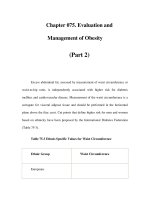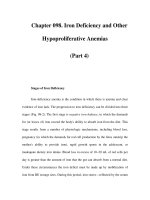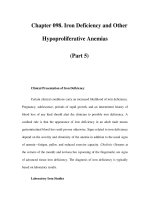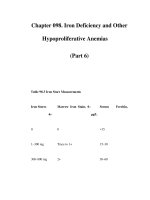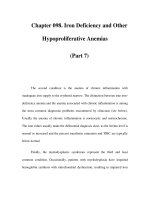Chapter 098. Iron Deficiency and Other Hypoproliferative Anemias (Part 9) pot
Bạn đang xem bản rút gọn của tài liệu. Xem và tải ngay bản đầy đủ của tài liệu tại đây (57.34 KB, 5 trang )
Chapter 098. Iron Deficiency and Other
Hypoproliferative Anemias
(Part 9)
Anemia of Acute and Chronic Inflammation/Infection (the Anemia of
Chronic Disease)
The anemia of chronic disease—which encompasses inflammation,
infection, tissue injury, and conditions (such as cancer) associated with the release
of proinflammatory cytokines—is one of the most common forms of anemia seen
clinically and probably the most important in the differential diagnosis of iron
deficiency, since many of the features of the anemia are brought about by
inadequate iron delivery to the marrow, despite the presence of normal or
increased iron stores. This is reflected by a low serum iron, increased red cell
protoporphyrin, a hypoproliferative marrow, transferrin saturation in the range of
15–20%, and a normal or increased serum ferritin. The serum ferritin values are
often the most distinguishing feature between true iron-deficiency anemia and the
iron-deficient erythropoiesis associated with inflammation. Typically, serum
ferritin values increase threefold over basal levels in the face of inflammation. All
of these changes are due to the effects of inflammatory cytokines and hepcidin, the
key iron regulatory hormone, acting at several levels of erythropoiesis (Fig. 98-4).
Figure 98-4
Suppression of erythropoiesis by inflammatory cytokines.
Through the release of tumor necrosis factor (TNF) and interferon γ (IFN-
γ), neoplasms and bacterial infections suppress erythropoietin (EPO) production
and the proliferation of erythroid progenitors [erythroid burst-
forming units and
erythroid colony-forming units (BFU/CFU-
E)]. The mediators in patients with
vasculitis and rheumatoid arthritis include interleukin 1 (IL-1) and IFN-
γ. The red
arrows indicate sites of inflammatory cytokine inhibitory effects.
Interleukin 1 (IL-1) directly decreases EPO production in response to
anemia. IL-1, acting through accessory cell release of interferon γ (IFN-γ),
suppresses the response of the erythroid marrow to EPO—an effect that can be
overcome by EPO administration in vitro and in vivo. In addition, tumor necrosis
factor (TNF), acting through the release of IFN-γ by marrow stromal cells, also
suppresses the response to EPO. Hepcidin, made by the liver, is increased in
inflammation and acts to suppress iron absorption and iron release from storage
sites. The overall result is a chronic hypoproliferative anemia with classic changes
in iron metabolism. The anemia is further compounded by a mild to moderate
shortening in red cell survival.
With chronic inflammation, the primary disease will determine the severity
and characteristics of the anemia. For instance, many patients with cancer also
have anemia that is typically normocytic and normochromic. In contrast, patients
with long-standing active rheumatoid arthritis or chronic infections such as
tuberculosis will have a microcytic, hypochromic anemia. In both cases, the bone
marrow is hypoproliferative, but the differences in red cell indices reflect
differences in the availability of iron for hemoglobin synthesis. Occasionally,
conditions associated with chronic inflammation are also associated with chronic
blood loss. Under these circumstances, a bone marrow aspirate stained for iron
may be necessary to rule out absolute iron deficiency. However, the administration
of iron in this case will correct the iron deficiency component of the anemia and
leave the inflammatory component unaffected.
The anemia associated with acute infection or inflammation is typically
mild but becomes more pronounced over time. Acute infection can produce a fall
in hemoglobin levels of 2–3 g/dL within 1 or 2 days; this is largely related to the
hemolysis of red cells near the end of their natural life span. The fever and
cytokines released exert a selective pressure against cells with more limited
capacity to maintain the red cell membrane. In most individuals the mild anemia is
reasonably well tolerated, and symptoms, if present, are associated with the
underlying disease. Occasionally, in patients with preexisting cardiac disease,
moderate anemia (hemoglobin 10–11 g/dL) may be associated with angina,
exercise intolerance, and shortness of breath. The erythropoietic profile that
distinguishes the anemia of inflammation from the other causes of
hypoproliferative anemias is shown in Table 98-6.


